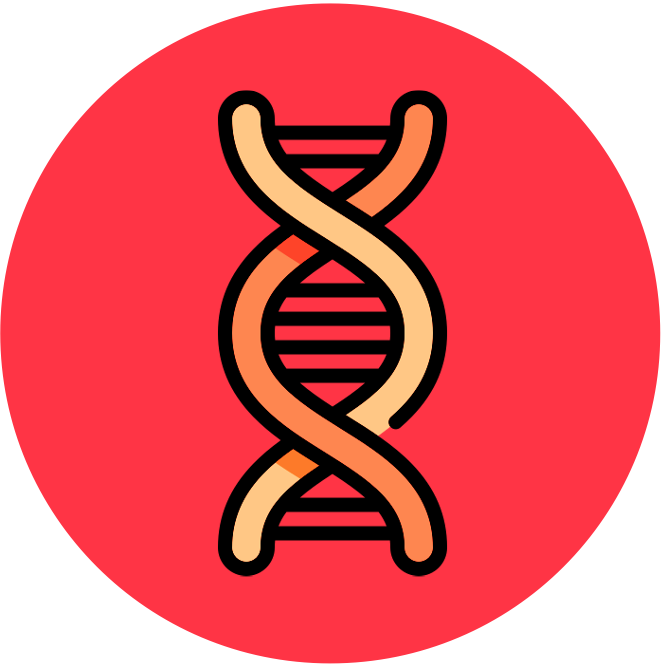

Inheritance
SL Content Statements
-
D3.2.1
Production of haploid gametes in parents and their fusion to form a diploid zygote as the means of inheritance
-
Students should understand that this pattern of inheritance is common to all eukaryotes with a sexual life cycle. They should also understand that a diploid cell has two copies of each autosomal gene.
-
D3.2.2
Methods for conducting genetic crosses in flowering plants
-
Use the terms “P generation”, “F1 generation”, “F2 generation” and “Punnett grid”. Students should understand that pollen contains male gametes and that female gametes are located in the ovary, so pollination is needed to carry out a cross. They should also understand that plants such as peas produce both male and female gametes on the same plant, allowing self-pollination and therefore self-fertilization. Mention that genetic crosses are widely used to breed new varieties of crop or ornamental plants.
-
D3.2.3
Genotype as the combination of alleles inherited by an organism
-
Students should use and understand the terms “homozygous” and “heterozygous”, and appreciate the distinction between genes and alleles.
-
D3.2.4
Phenotype as the observable traits of an organism resulting from genotype and environmental factors
-
Students should be able to suggest examples of traits in humans due to genotype only and due to environment only, and also traits due to interaction between genotype and environment.
-
D3.2.5
Effects of dominant and recessive alleles on phenotype
-
Students should understand the reasons that both a homozygous-dominant genotype and a heterozygous genotype for a particular trait will produce the same phenotype.
-
D3.2.6
Phenotypic plasticity as the capacity to develop traits suited to the environment experienced by an organism, by varying patterns of gene expression
-
Phenotypic plasticity is not due to changes in genotype, and the changes in traits may be reversible during the lifetime of an individual.
-
D3.2.7
Phenylketonuria as an example of a human disease due to a recessive allele
-
Phenylketonuria (PKU) is a recessive genetic condition caused by mutation in an autosomal gene that codes for the enzyme needed to convert phenylalanine to tyrosine.
-
D3.2.8
Single-nucleotide polymorphisms and multiple alleles in gene pools
-
Students should understand that any number of alleles of a gene can exist in the gene pool but an individual only inherits two.
-
D3.2.9
ABO blood groups as an example of multiple alleles
-
Use IA, IB and i to denote the alleles.
-
D3.2.10
Incomplete dominance and codominance
-
Students should understand the differences between these patterns of inheritance at the phenotypic level. In codominance, heterozygotes have a dual phenotype. Include the AB blood type (IAIB) as an example. In incomplete dominance, heterozygotes have an intermediate phenotype. Include four o'clock flower or marvel of Peru (Mirabilis jalapa) as an example.
-
D3.2.11
Sex determination in humans and inheritance of genes on sex chromosomes
-
Students should understand that the sex chromosome in sperm determines whether a zygote develops certain male-typical or female-typical physical characteristics and that far more genes are carried by the X chromosome than the Y chromosome.
-
D3.2.12
Haemophilia as an example of a sex-linked genetic disorder
-
Show alleles carried on X chromosomes as superscript letters on an uppercase X.
-
D3.2.13
Pedigree charts to deduce patterns of inheritance of genetic disorders
-
Students should understand the genetic basis for the prohibition of marriage between close relatives in many societies.
NOS: Scientists draw general conclusions by inductive reasoning when they base a theory on observations of some but not all cases. A pattern of inheritance may be deduced from parts of a pedigree chart and this theory may then allow genotypes of specific individuals in the pedigree to be deduced. Students should be able to distinguish between inductive and deductive reasoning.
-
D3.2.14
Continuous variation due to polygenic inheritance and/or environmental factors
-
Use skin colour in humans as an example.
AOS: Students should understand the distinction between continuous variables such as skin colour and discrete variables such as ABO blood group. They should also be able to apply measures of central tendency such as mean, median and mode.
-
D3.2.15
Box-and-whisker plots to represent data for a continuous variable such as student height
-
AOS: Students should use a box-and-whisker plot to display six aspects of data: outliers, minimum, first quartile, median, third quartile and maximum. A data point is categorized as an outlier if it is more than 1.5 × IQR (interquartile range) above the third quartile or below the first quartile.



